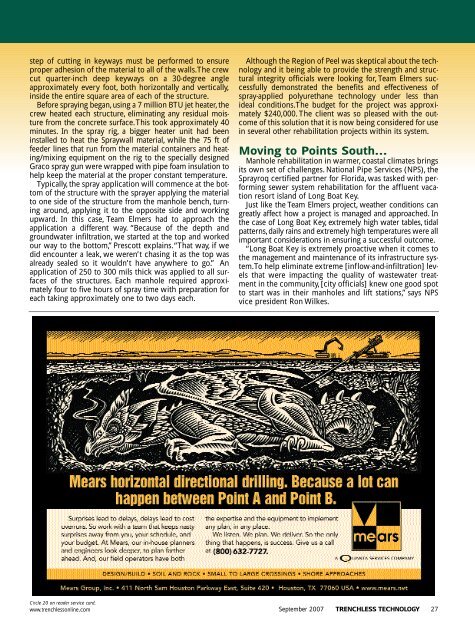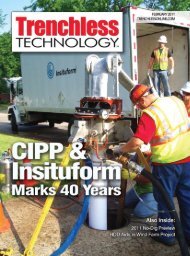Author: Professor, Dr. Dietrich Stein - TrenchlessOnline
Author: Professor, Dr. Dietrich Stein - TrenchlessOnline
Author: Professor, Dr. Dietrich Stein - TrenchlessOnline
Create successful ePaper yourself
Turn your PDF publications into a flip-book with our unique Google optimized e-Paper software.
step of cutting in keyways must be performed to ensure<br />
proper adhesion of the material to all of the walls.The crew<br />
cut quarter-inch deep keyways on a 30-degree angle<br />
approximately every foot, both horizontally and vertically,<br />
inside the entire square area of each of the structure.<br />
Before spraying began,using a 7 million BTU jet heater,the<br />
crew heated each structure, eliminating any residual moisture<br />
from the concrete surface.This took approximately 40<br />
minutes. In the spray rig, a bigger heater unit had been<br />
installed to heat the Spraywall material, while the 75 ft of<br />
feeder lines that run from the material containers and heating/mixing<br />
equipment on the rig to the specially designed<br />
Graco spray gun were wrapped with pipe foam insulation to<br />
help keep the material at the proper constant temperature.<br />
Typically, the spray application will commence at the bottom<br />
of the structure with the sprayer applying the material<br />
to one side of the structure from the manhole bench, turning<br />
around, applying it to the opposite side and working<br />
upward. In this case, Team Elmers had to approach the<br />
application a different way. “Because of the depth and<br />
groundwater infiltration, we started at the top and worked<br />
our way to the bottom,” Prescott explains.“That way, if we<br />
did encounter a leak, we weren’t chasing it as the top was<br />
already sealed so it wouldn’t have anywhere to go.” An<br />
application of 250 to 300 mils thick was applied to all surfaces<br />
of the structures. Each manhole required approximately<br />
four to five hours of spray time with preparation for<br />
each taking approximately one to two days each.<br />
Circle 20 on reader service card.<br />
www.trenchlessonline.com<br />
Although the Region of Peel was skeptical about the technology<br />
and it being able to provide the strength and structural<br />
integrity officials were looking for, Team Elmers successfully<br />
demonstrated the benefits and effectiveness of<br />
spray-applied polyurethane technology under less than<br />
ideal conditions.The budget for the project was approximately<br />
$240,000. The client was so pleased with the outcome<br />
of this solution that it is now being considered for use<br />
in several other rehabilitation projects within its system.<br />
Moving to Points South…<br />
Manhole rehabilitation in warmer,coastal climates brings<br />
its own set of challenges. National Pipe Services (NPS), the<br />
Sprayroq certified partner for Florida, was tasked with performing<br />
sewer system rehabilitation for the affluent vacation<br />
resort island of Long Boat Key.<br />
Just like the Team Elmers project, weather conditions can<br />
greatly affect how a project is managed and approached. In<br />
the case of Long Boat Key, extremely high water tables, tidal<br />
patterns,daily rains and extremely high temperatures were all<br />
important considerations in ensuring a successful outcome.<br />
“Long Boat Key is extremely proactive when it comes to<br />
the management and maintenance of its infrastructure system.To<br />
help eliminate extreme [inflow-and-infiltration] levels<br />
that were impacting the quality of wastewater treatment<br />
in the community,[city officials] knew one good spot<br />
to start was in their manholes and lift stations,” says NPS<br />
vice president Ron Wilkes.<br />
September 2007 TRENCHLESS TECHNOLOGY 27








